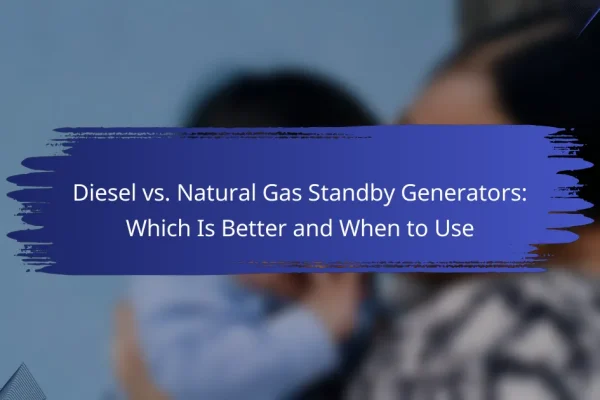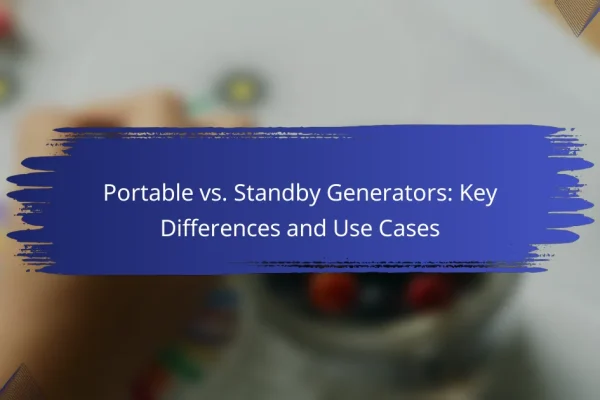What are the types of standby generators?
Standby generators are backup power systems designed to automatically provide electricity during an outage. They come in various types, each suited for different needs and applications.
Transfer switch generators
Transfer switch generators are permanently installed units that automatically switch power from the grid to the generator during an outage. They require a transfer switch to safely disconnect the home from the utility supply, ensuring that power is restored quickly and safely.
When selecting a transfer switch generator, consider the power output needed to support essential appliances. These generators typically range from 5,000 to 20,000 watts, making them suitable for residential use.
Portable generators
Portable generators are versatile units that can be easily moved and used for various applications, from home backup to outdoor events. They are powered by gasoline or propane and typically provide lower wattage compared to standby generators.
When using a portable generator, ensure it is placed outdoors to avoid carbon monoxide buildup. These generators usually offer power outputs between 1,000 and 10,000 watts, making them ideal for smaller loads.
Inverter generators
Inverter generators provide clean and stable power, making them suitable for sensitive electronics like computers and smartphones. They use advanced technology to produce electricity that is less prone to fluctuations.
These generators are often quieter and more fuel-efficient than traditional models, with outputs ranging from 1,000 to 4,000 watts. They are ideal for camping or tailgating, where noise and space are concerns.
Natural gas generators
Natural gas generators are a reliable option for homeowners looking for a continuous power supply. They are connected to the natural gas line, eliminating the need for fuel storage and providing a constant energy source.
These generators can run for extended periods and typically range from 10,000 to 25,000 watts. They are particularly advantageous in areas where natural gas is readily available and can be more economical in the long run.
Diesel generators
Diesel generators are known for their durability and efficiency, making them a popular choice for commercial and industrial applications. They typically offer higher power outputs and longer run times compared to gasoline generators.
These generators can range from 5,000 to over 100,000 watts, depending on the application. While they may have higher initial costs, their longevity and lower fuel consumption can provide significant savings over time.
How do transfer switch generators work?
Transfer switch generators operate by automatically switching the power source from the utility grid to the generator during an outage. This ensures that essential appliances and systems remain powered without manual intervention.
Automatic power restoration
Automatic power restoration is a key feature of transfer switch generators. When a power outage occurs, the transfer switch detects the loss of utility power and signals the generator to start. This process typically takes only a few seconds, allowing for minimal disruption to your home or business.
Once the generator is running, the transfer switch disconnects from the utility grid and connects to the generator, ensuring a seamless transition to backup power. When utility power is restored, the switch automatically reverts back, turning off the generator.
Seamless transition
The seamless transition provided by transfer switch generators is crucial for maintaining power continuity. This system eliminates the need for manual switching, which can be time-consuming and risky during emergencies. The automatic operation ensures that critical systems, such as refrigeration and heating, remain functional without interruption.
To achieve a seamless transition, it is important to choose a generator with a compatible transfer switch that meets local electrical codes. Regular maintenance of both the generator and transfer switch is essential to ensure reliable performance during outages.
What are the benefits of natural gas generators?
Natural gas generators offer several advantages, including lower emissions and cost-effective operation. These benefits make them an appealing choice for both residential and commercial backup power solutions.
Lower emissions
Natural gas generators produce significantly fewer pollutants compared to diesel or gasoline generators. They emit lower levels of carbon dioxide, nitrogen oxides, and particulate matter, contributing to improved air quality. This makes them a more environmentally friendly option, especially in urban areas where air quality regulations are strict.
Additionally, many regions encourage the use of cleaner energy sources through incentives or rebates, which can further enhance the appeal of natural gas generators. By choosing this type of generator, users can align with sustainability goals and potentially qualify for financial benefits.
Cost-effective operation
Operating a natural gas generator is often more economical than using diesel or gasoline models. Natural gas prices tend to be lower and more stable, leading to reduced fuel costs over time. This can result in significant savings, especially for users who rely on generators frequently.
Moreover, maintenance costs for natural gas generators are generally lower due to their cleaner burning nature, which reduces wear and tear on engine components. Users should consider these factors when evaluating the long-term financial implications of their generator choice.
What factors should you consider when choosing a standby generator?
When selecting a standby generator, consider power output requirements, fuel type availability, and installation space. These factors will help ensure that the generator meets your needs effectively and fits within your home or business environment.
Power output requirements
Power output requirements determine the generator’s capacity to handle your electrical load during an outage. Assess your essential appliances and systems, such as heating, cooling, and refrigeration, to estimate the total wattage needed. A common recommendation is to choose a generator that can provide at least 20-30% more power than your calculated needs to accommodate any surges.
For example, if your essential devices require 5,000 watts, consider a generator with a capacity of around 6,500 to 7,000 watts. This buffer will help ensure reliable performance during peak usage.
Fuel type availability
Fuel type availability is crucial for ensuring that your standby generator can operate when needed. Common fuel options include natural gas, propane, and diesel. Evaluate the availability and cost of these fuels in your area, as this will affect both the generator’s operational efficiency and your long-term expenses.
Natural gas is often preferred for its convenience and lower emissions, while propane can be stored for extended periods. Diesel generators are typically more powerful but may have higher maintenance needs and fuel costs.
Installation space
Installation space is a key consideration when choosing a standby generator, as it must fit within your property and comply with local regulations. Measure the area where you plan to install the generator, ensuring there is adequate clearance for ventilation and maintenance access.
Additionally, check local building codes for any restrictions on generator placement, such as distance from windows or property lines. A typical installation may require a space of at least 3-5 feet around the generator for safety and accessibility.
How do standby generators compare in pricing?
Standby generators vary significantly in pricing based on their type, capacity, and fuel source. Generally, costs can range from a few thousand to over ten thousand dollars, depending on the features and installation requirements.
Cost of transfer switch generators
Transfer switch generators typically start around $2,000 and can go up to $5,000 or more, depending on the generator’s capacity and brand. These systems allow for safe and efficient power transfer during outages, which is essential for homes and businesses.
Installation costs for transfer switches can add another $500 to $2,000, depending on the complexity of the setup and local labor rates. It’s crucial to hire a qualified electrician to ensure compliance with local codes.
Cost of diesel generators
Diesel generators are generally more expensive, with prices ranging from $5,000 to $15,000 for residential units. They are favored for their durability and fuel efficiency, making them suitable for long-term power outages.
Operating costs can be higher due to diesel fuel prices, which fluctuate based on market conditions. Maintenance is also essential, as diesel engines require regular servicing to ensure reliability.
Cost of natural gas generators
Natural gas generators usually range from $3,000 to $10,000, making them a popular choice for homeowners. They are often more economical to operate compared to diesel generators, as natural gas tends to be less expensive.
Installation may require a connection to a natural gas line, which can incur additional costs. However, once installed, these generators provide a continuous and reliable power source with lower emissions than their diesel counterparts.












